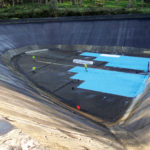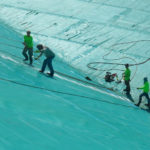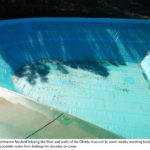1-2 combo delivers waterproofing at Hawaii water impoundment structure
By Del Williams
Introduction
For decades, polyurea coatings have been spray applied directly to properly prepared concrete, metal, and geotextile substrates on the jobsite using special equipment and trained applicators. However, recent polyurea products and process improvements are now speeding the installation process with even higher quality and performance results.
The process involves pre-spraying geotextile composite liners with a pure polyurea coating in a special quality controlled factory environment with robotically controlled equipment. This speeds production and also ensures a uniform coating thickness throughout the liner.
The pre-sprayed liners are then shipped to the jobsite and secured to the substrate. The same polyurea material used to produce the liner is then used to “glue” or fuse the panels together. Because it is the same exact material, the individual liner pieces become a single monolithic, seamless, waterproof membrane that is extremely durable, flexible, and chemical resistant.
In addition, using pre-sprayed liners greatly reduces or eliminates jobsite and environmental challenges such as wind and weather that can slow or even stop production and installation.
As a result, these liners are becoming the state-of-the-art technology for both facility owners and the installing contractors because of their physical performance characteristics, seamless waterproof construction, rapid installation, and reusability.
Waterproofing water impoundment structures
The new seamless pure polyurea liners are proving to be an effective technique to waterproof large concrete and asphalt structures such as ponds, tanks, and reservoirs.
These massive structures, typically made of concrete or asphalt, can hold millions of gallons of water that is used for drinking water, fire suppression, and even generating electricity.
The difficulty comes when these large structures develop water leaks through deteriorating asphalt and concrete. Cracks in these materials can also develop over time due to reasons ranging from earth movement to daily or seasonal temperature changes that cause expansion and contraction, often referred to as freeze-thaw.
Even the weight and movement of millions of gallons of water can cause tiny cracks to open to 1/8in. or larger when filled with water. The water loss, which can become hundreds of gallons per minute, can lead to repaving projects that can cost millions of dollars every 10–15 years.
To waterproof these structures and minimize water loss due to cracks, some facilities are installing durable waterproof membranes made from pre-sprayed geotextile fabric panels.
As a coating, polyurea is ideal for waterproofing concrete, steel, and asphalt because it exhibits superior physical properties such as high elongation, crack bridging, hardness, and tensile strength.
Case study
Maui Water Department’s Olinda
Treatment Facility
This type of polyurea-coated geotextile panel was used recently to stop water leakage at an 8.5 million gallon, 60,000sf, 40ft-deep, concrete reservoir at the Maui Water Department’s Olinda Water Treatment Facility in Maui, Hawaii.
The reservoir was located in the mountains, accessible by a rugged gravel road that would be difficult for cement trucks to navigate. Because of the condition of the reservoir’s floor, jack hammering old concrete, using a crane to remove it, and pouring new concrete would be difficult and costly.
Instead, the restoration contractor’s six-man crew installed the pre-sprayed geotextile at 80 mils to the interior of the reservoir walls up over its rock parapet. The pre-sprayed panels were rolled out like a waterproof blanket onsite. Once rolled out, the edges were matched and the seams sprayed with polyurea.
The crew mechanically fastened the geotextile to the reservoir walls with stainless termination bars and then sprayed over the bars. They also sprayed the polyurea on stairs, sumps, and penetrations, and tied these to the geotextile.
Del Williams is a technical writer based in Torrance, Calif. He writes about health, business, technology, and education issues.
Photos courtesy VersaFlex Inc.
Project Highlights
Restoration of aging 8.5 million gallon concrete reservoir at Olinda Water Treatment Facility, Maui, Hawaii, using polyurea-coated geotextile panels.
Location
Maui, Hawaii, USA
Client
Maui Water Department, Olinda Facility
Restoration contractor
Abhe & Svoboda Inc.
Pre-sprayed geotextile liners
FlexTain
Pure polyurea
AquaVers 405
More information
Geosynthetic Institute
Folsom, PA., USA
VersaFlex
Kansas City, Kan., USA
 TEXTILES.ORG
TEXTILES.ORG









hello sir i need Technical
with a machine To come to Jordan to spray a 60 square meter polyuria test
Dear Zaid,
The company that provided the pre-sprayed geotextile liners and the polyurea coating was VersaFlex Inc. of Kansas City, Missouri, USA. More information on the geotextile liners can be found at http://versaflex.com/products/pre-sprayed-liners/flextain-80/, and more information on the polyurea coating at http://versaflex.com/products/potable-water-systems/aquavers-405-potable-water-spray-polyurea/. There are links on both of these web pages that allow you to contact the company for more information.
Good luck!
Todd R. Berger
Editor, Geosynthetics